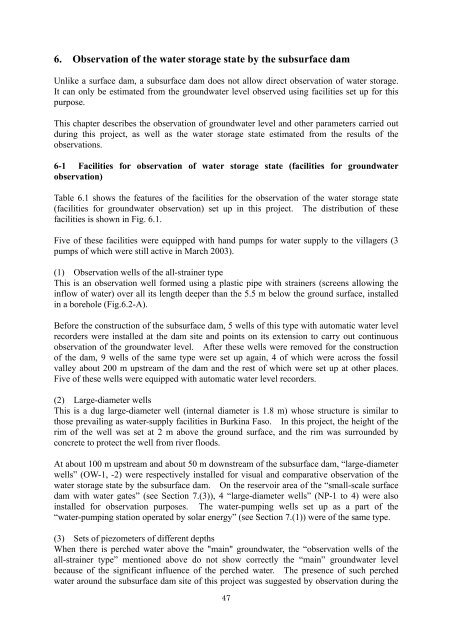SubSurface Dams - Sustainable Sanitation and Water Management ...
SubSurface Dams - Sustainable Sanitation and Water Management ...
SubSurface Dams - Sustainable Sanitation and Water Management ...
Create successful ePaper yourself
Turn your PDF publications into a flip-book with our unique Google optimized e-Paper software.
6. Observation of the water storage state by the subsurface damUnlike a surface dam, a subsurface dam does not allow direct observation of water storage.It can only be estimated from the groundwater level observed using facilities set up for thispurpose.This chapter describes the observation of groundwater level <strong>and</strong> other parameters carried outduring this project, as well as the water storage state estimated from the results of theobservations.6-1 Facilities for observation of water storage state (facilities for groundwaterobservation)Table 6.1 shows the features of the facilities for the observation of the water storage state(facilities for groundwater observation) set up in this project. The distribution of thesefacilities is shown in Fig. 6.1.Five of these facilities were equipped with h<strong>and</strong> pumps for water supply to the villagers (3pumps of which were still active in March 2003).(1) Observation wells of the all-strainer typeThis is an observation well formed using a plastic pipe with strainers (screens allowing theinflow of water) over all its length deeper than the 5.5 m below the ground surface, installedin a borehole (Fig.6.2-A).Before the construction of the subsurface dam, 5 wells of this type with automatic water levelrecorders were installed at the dam site <strong>and</strong> points on its extension to carry out continuousobservation of the groundwater level. After these wells were removed for the constructionof the dam, 9 wells of the same type were set up again, 4 of which were across the fossilvalley about 200 m upstream of the dam <strong>and</strong> the rest of which were set up at other places.Five of these wells were equipped with automatic water level recorders.(2) Large-diameter wellsThis is a dug large-diameter well (internal diameter is 1.8 m) whose structure is similar tothose prevailing as water-supply facilities in Burkina Faso. In this project, the height of therim of the well was set at 2 m above the ground surface, <strong>and</strong> the rim was surrounded byconcrete to protect the well from river floods.At about 100 m upstream <strong>and</strong> about 50 m downstream of the subsurface dam, “large-diameterwells” (OW-1, -2) were respectively installed for visual <strong>and</strong> comparative observation of thewater storage state by the subsurface dam. On the reservoir area of the “small-scale surfacedam with water gates” (see Section 7.(3)), 4 “large-diameter wells” (NP-1 to 4) were alsoinstalled for observation purposes. The water-pumping wells set up as a part of the“water-pumping station operated by solar energy” (see Section 7.(1)) were of the same type.(3) Sets of piezometers of different depthsWhen there is perched water above the "main" groundwater, the “observation wells of theall-strainer type” mentioned above do not show correctly the “main” groundwater levelbecause of the significant influence of the perched water. The presence of such perchedwater around the subsurface dam site of this project was suggested by observation during the47
















